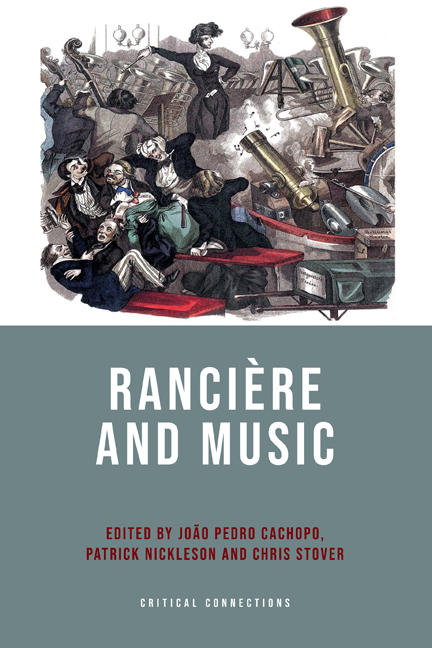Book contents
- Frontmatter
- Contents
- List of Examples
- Acknowledgements
- Notes on Contributors
- Introduction
- Part I: Music and Noise
- 1 Musique concrète and the Aesthetic Regime of Art
- 2 ‘Rip it up and start again’: Reconfigurations of the Audible under the Aesthetic Regime of the Arts
- 3 A Lesson in Low Music
- Part II: Politics of History
- 4 Wandering with Rancière: Sound and Structure under the Aesthetic Regime
- 5 Staging Music in the Aesthetic Regime of Art: Rancière, Berlioz and the Bells of Harold en Italie
- 6 Rancière on Music, Rancière’s Non-music
- 7 Coloured Opera and the Violence of Dis-identification
- Part III: Politics of Interaction
- 8 Musical Politics in the Cuban Police Order
- 9 Rancière and Improvisation: Reading Contingency in Music and Politics
- 10 Rancière’s Affective Impropriety
- Part IV: Encounters and Challenges
- 11 Rancière, Resistance and the Problem of Commemorative Art: Music Displacing Violence Displacing Music
- 12 Stain
- 13 On Shoemakers and Related Matters: Rancière and Badiou on Richard Wagner
- 14 Roll Over the Musical Boundaries: A Few Milestones for the Implementation of an Equal Method in Musicology
- Afterword
- A Distant Sound
- Works Cited
- Index
4 - Wandering with Rancière: Sound and Structure under the Aesthetic Regime
Published online by Cambridge University Press: 03 October 2020
- Frontmatter
- Contents
- List of Examples
- Acknowledgements
- Notes on Contributors
- Introduction
- Part I: Music and Noise
- 1 Musique concrète and the Aesthetic Regime of Art
- 2 ‘Rip it up and start again’: Reconfigurations of the Audible under the Aesthetic Regime of the Arts
- 3 A Lesson in Low Music
- Part II: Politics of History
- 4 Wandering with Rancière: Sound and Structure under the Aesthetic Regime
- 5 Staging Music in the Aesthetic Regime of Art: Rancière, Berlioz and the Bells of Harold en Italie
- 6 Rancière on Music, Rancière’s Non-music
- 7 Coloured Opera and the Violence of Dis-identification
- Part III: Politics of Interaction
- 8 Musical Politics in the Cuban Police Order
- 9 Rancière and Improvisation: Reading Contingency in Music and Politics
- 10 Rancière’s Affective Impropriety
- Part IV: Encounters and Challenges
- 11 Rancière, Resistance and the Problem of Commemorative Art: Music Displacing Violence Displacing Music
- 12 Stain
- 13 On Shoemakers and Related Matters: Rancière and Badiou on Richard Wagner
- 14 Roll Over the Musical Boundaries: A Few Milestones for the Implementation of an Equal Method in Musicology
- Afterword
- A Distant Sound
- Works Cited
- Index
Summary
The three regimes
Rancière's well-known distinction between three artistic regimes is immediately telling for the musicologist considering the evolution of Western art music since the sixteenth century. A regime is defined by Rancière as ‘a specific type of link between the production of works (or artistic practice), and the forms of visibility that these forms will take, implying different modes to conceptualise both’. Coming after the ‘ethical regime of the images’ where such a thing as ‘art’ is not yet identified, the ‘representative regime’, under the overwhelming influence of Aristotle's theories, rests on hierarchies encapsulated by tragedy, installed as the ideal model for all of the ‘fine arts’. Valuable forms (or, within each art, valuable strategies and techniques) are those clearly evincing, or resting on, the Aristotelian muthos. The central importance of the fable (defined as a logical sequence marked by a reversal, the peripeteia, and leading to an unforeseen end) establishes the ‘representational primacy of action over character, of narration over description, the hierarchy of artistic genres following the dignity of their topics, along with the very superiority of the art expressing the act of speaking’. Such artistic hierarchies imply and/or consolidate social hierarchies: the exemplary fable deals with those who encounter a destiny (not with those for whom ‘time just passes’), those who have a right to speak or to be spoken of, those who participate in public affairs and dominate the public space, those who are visible.
Finally, under the ‘aesthetic regime of art’ that emerged at the end of the eighteenth century, art is defined as the ‘essence’ that all arts have in common. This essence, however, is a negative force that overthrows the reign of muthos and dissolves its hierarchies. Art is characterised by a ‘mode of presenting what is offered to the senses [le sensible], now exempted from its ordinary connections, as inhabited by a heterogeneous force, the power of Thought, a thought in turn alienated from itself’. Hence the two fundamental procedures characteristic of the aesthetic regime: on the one hand, the continuous rereading and reworking of the past, transformed, fragmented or restaged in new artistic productions and, on the other, the integration of what is the very opposite of Thought – matter, litter, debris – and which resists its capture.
- Type
- Chapter
- Information
- Ranciere and Music , pp. 97 - 116Publisher: Edinburgh University PressPrint publication year: 2020



